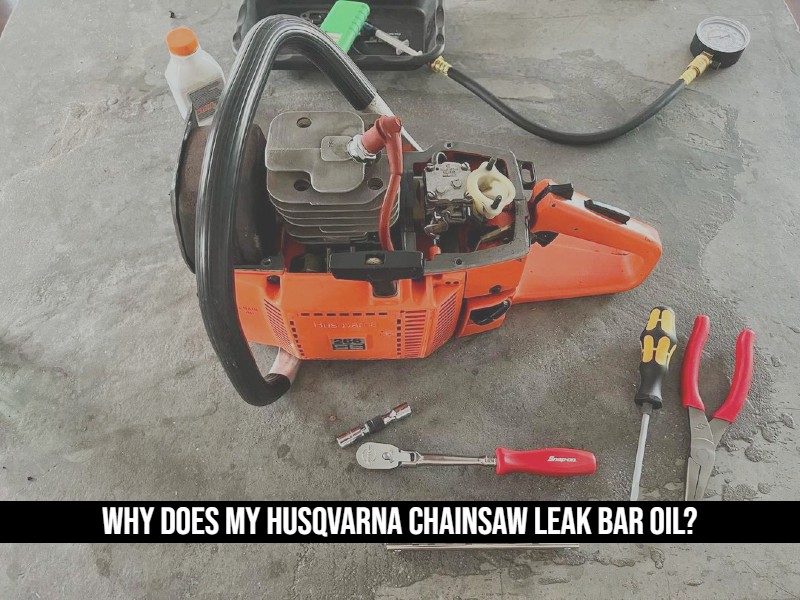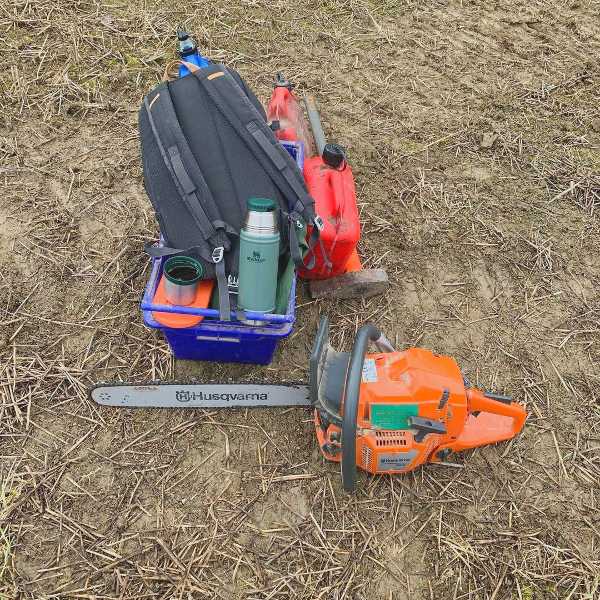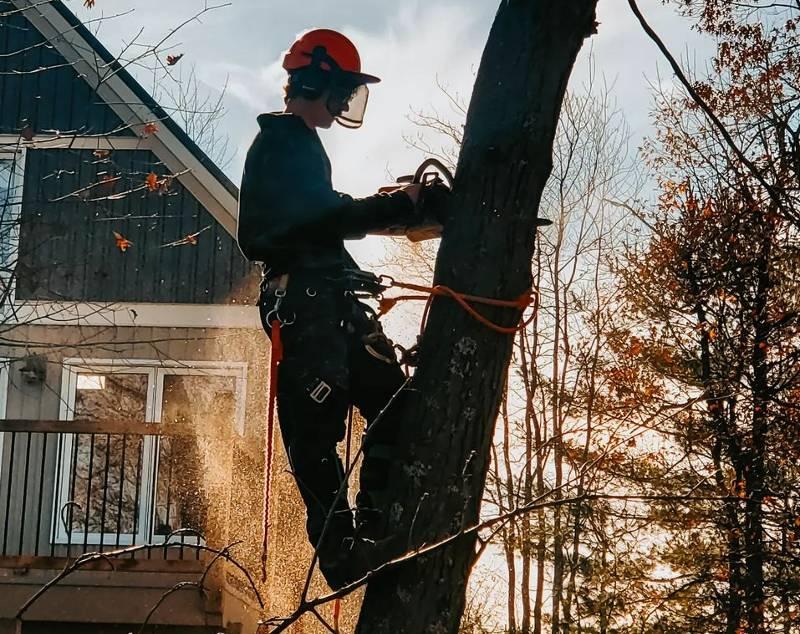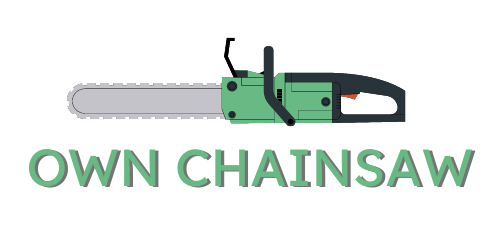Chainsaws are an important tool for cutting wood, and when your Husqvarna chainsaw leaks bar oil, it can make a mess and throw off your work.
Several reasons why your chainsaw might be dripping bar oil, and luckily they’re all easily fixable. The most common culprit of bar oil leaks is overfilling the oil tank, dripping oil from the guide bar, and oil droplet formation issues.
At first glance, it might seem daunting to figure out why your Husqvarna chainsaw is leaking bar oil. But trust us, it’s nothing to be intimidated by.
There are a few simple steps you can take to get your chainsaw back on track and running like a charm.

What is a Chain saw lubrication system and how does it work?
When it comes to maintaining a chainsaw, proper chain and bar lubrication is essential. Without this, the chainsaw may suffer premature wear and tear, resulting in less efficient and safe performance.
Chain and bar lubrication ensures that the chainsaw remains in top shape and can be used for many years to come.
A chainsaw lubrication system is designed to keep the chainsaw running at optimal performance and to extend its service life.
The system consists of a lubricant reservoir, a lubricant pump, and an oil-pump drive. The lubricant reservoir holds oil or lubricant and the pump moves the oil from the reservoir to the chain saw bar and chain.
Working
The oil pump drive is responsible for controlling the amount of oil that is pumped through the system.
The lubricant circulates to the bar and chain of the chainsaw. As the chain passes through the guide bar, the oil is forced through the openings in the guide bar, lubricating the chain and bar as it moves through.
This helps to reduce the friction between the chain and bar, reducing the amount of heat produced and the amount of wear and tear on the chain and bar.
In addition to providing lubrication for the chain and bar, the lubricant also helps prevent kickback from the chainsaw.
Kickback occurs when the chain becomes stuck in the bar and is suddenly released. The lubricant helps to reduce the kickback by allowing the chain to move more easily through the bar.
To maintain optimal performance, be sure to check the lubricant reservoir and pump regularly for damage or wear.
If the reservoir and pump are not functioning properly, the lubricant may not be reaching the bar and chain, leading to reduced performance and potentially unsafe operation of the chainsaw.
The correct chain saw lubricant must be used when lubricating. The owner’s manual for most chain saws specifies the type of lubricant to use.
You should use a specialized chain saw lubricant if the type of lubricant is not specified. The chainsaw should not be lubricated with solvents or chemicals, as they can damage it.
10 Reasons For Husqvarna Chainsaw Leak Bar Oil & Their Solutions

Having a chainsaw that leaks bar oil can be a big hassle. Not only can it be messy and time-consuming to clean up, but it can also reduce the efficiency of the saw by reducing its cutting power.
If you’ve ever experienced this, you’re probably wondering why your bar oil is leaking in the first place. The good news is that there are a few common causes for bar oil leaking from your chainsaw.
Knowing what’s causing the leak can help you address it quickly and keep your chainsaw in top condition.
1. Overfilling the oil tank
As chainsaw users know, oil is essential to the health and performance of the saw. However, if you overfill the oil tank in your Husqvarna chainsaw, it can cause the bar oil to leak.
This can create a mess and reduce the performance of your saw. Overfilling occurs when you add too much oil to the tank, either due to not paying attention to the oil level indicator or trying to get better performance from your saw. Overfilling also causes oil to seep out of the tank, leaving a puddle on the floor.
To avoid this, always fill your chainsaw tank to the indicator’s maximum level. Make sure to use the right type of bar oil for your model. If you do overfill, wipe up the excess and check your chainsaw regularly for damage.
2. Oil dripping from the guide bar
Oil leaking from the guide bar of a chainsaw made by Husqvarna is a real nuisance. The problem is caused by a build-up of oil in the guide bar groove, which then drips out when the chainsaw is switched off. This can be a mess to clean up and can also damage surfaces if it runs off the saw.
The solution is to ensure that the guide bar groove is clean and free of oil before the saw is put away. Remove the chain from the guide bar and wipe away the excess oil with a dry cloth.
In this way, less oil will drip onto the guide bar in the future. Check the guide bar regularly for signs of wear and tear, as this may indicate that the oil is not being distributed evenly and needs to be adjusted.
3. Oil droplet formation
The problem of oil droplet formation causing bar oil to leak from Husqvarna chainsaws is caused by the chainsaw’s high speed of operation.
The oil mist released during operation can condense and form droplets, which can then fall across the saw and collect in crevices. This can lead to a messy oil spill on the saw and any nearby surface.
The solution to this problem is to ensure proper maintenance and lubrication of the chainsaw. This includes regularly checking the chain’s tension, ensuring the chain is correctly aligned, and ensuring the chain oil is of the correct viscosity.
Regularly clean the saw and remove any oil droplets that may have formed. Doing so will ensure that the saw runs more smoothly and help to prevent any messy oil leaks.
4. Oil gathering in recesses
Having a leak of bar oil from your Husqvarna chainsaw can be a frustrating issue. The cause of the leak is typically due to the bar oil gathering in recesses around the sprocket and under the clutch cover. This happens naturally, as some lubricating oil is lost when the chain passes around these parts.
To solve this issue, it is important to regularly check the chainsaw and clean any build-up of oil from the recesses.
Additionally, the user should use the proper grade of oil for their chainsaw and ensure that it is filled to the correct level. By following these steps, the user can prevent their chainsaw from leaking bar oil.
5. Clogged Oil Reservoir
A Husqvarna chainsaw leaking bar oil can be caused by a clogged oil reservoir. This can happen when the oil filter gets clogged or when there is a buildup of residue inside the reservoir.
The oil reservoir is located in the bottom part of the chainsaw and is responsible for collecting and storing oil to lubricate the parts of the chainsaw during operation. If the oil reservoir becomes clogged, the oil is unable to travel through the system and will instead leak out from the bar.
The user should inspect the oil filter and clear any obstructions before attempting to resolve this issue. It’s time to change the filter if it’s still blocked.
Following that, the user may refill the reservoir with new bar oil and check to make sure it is not blocked. If the oil leak persists, the user should examine the oil line for any evidence of corrosion or deterioration and replace it if required.
The final step is for the user to inspect the bar and chain for any signs of damage and replace them as necessary.
6. Old, worn-out O-ring or a loose oil tank cap
Whether the oil tank cap is loose or the O-ring is worn out, either can cause a Husqvarna chainsaw to leak bar oil. The O-ring is responsible for sealing the connection between the oil tank and the bar oil feed tube. Over time, the O-ring can become brittle and break, resulting in a leak. Additionally, if it is not properly tightened, it may allow oil to leak out.
To fix the issue, the first step is to check and replace the O-ring if necessary. This can be done by removing the oil pump and replacing the O-ring with a new one. Once the O-ring is replaced, it should be tightened to ensure a tight seal.
If the O-ring is not the culprit, the oil tank cap may need to be replaced as well. The process involves unscrewing the old cap and replacing it anew. Once the new cap is in place, the chainsaw should be checked again to make sure that no oil is leaking.
7. Chainsaw running idle
A Husqvarna chainsaw can leak bar oil if running without cutting. The cause of this problem is that the bar oil pump is driven by the motion of the clutch cover; when the chainsaw is running, the clutch cover spins and pushes oil up to the bar.
However, when the chainsaw isn’t cutting, the clutch cover stops spinning and the bar oil pump isn’t being driven. As a result, the oil begins to leak out of the bar.
One other thing that you can do to reduce the risk of bar oil leakage is to adjust the oiler setting. This is usually done with a knob that is on the side of the oiler.
You should turn it down until the oiler just stops dripping. This will ensure that the oiler is not over-lubricating the bar and chain.
8. Not properly Storing
Improper storage may result in bar oil leaking out, leading to an inconvenient and potentially dangerous mess. If a chainsaw is stored in an environment that is too moist or too hot, the seals around the bar oil reservoir can become dry, brittle, or cracked. This can then lead to oil leaking from the reservoir.
To combat this, it is essential to drain and refill the gas and oil before storing or using the saw. You can also store the saw on its side with the oil cover facing up and slightly open if the lubricant is still in the tank when you are storing it.
This will allow air to escape, preventing pressure from building up and causing the oil to leak out. Be sure to close the cap back up before using the saw to prevent messes. If you take these steps, you can help your saw last longer and avoid the dangerous and messy consequences of an oil leak.
9. Oil Tank Breathing System
Oil tank breathing systems are a common cause of oil leakage in Husqvarna chainsaws. Breathing systems are designed to ensure smooth lubricant flow and to prevent premature wear, but they can also cause oil leaks when air is compressed and pressure builds up.
To protect the public from potential hazards, these valves are required in certain locations.
When the nights are cold and the days are hot, the pressure inside the oil tank may increase due to temperature variations.
A small amount of oil is forced onto the guide bar, which must be contained and removed. Most often, this oil will drip down the side of the chainsaw, resulting in oil leakage.
Fortunately, there are several solutions to this issue. First, the chainsaw can be stored in a warm place or a temperature-controlled environment.
This will help to maintain consistent temperature differences and reduce the potential for oil leakage. As an additional safety feature, the oil tank can be equipped with a pressure regulator. To ensure proper airflow, the air filter should be checked and cleaned regularly to prevent clogging.
10. Oil Pump
One of the common causes of the leak is a worn or damaged oil pump gasket. The gasket seals the oil inside the pump, preventing it from leaking out. If the gasket is worn or damaged, the oil will leak from the pump, creating a mess and potentially damaging other components of the chainsaw.
The best way to fix the problem is to replace the gasket with a new one. This should stop the leak and restore the chainsaw to proper working order.
If the leak persists after replacing the gasket, it is likely due to a different issue, such as a cracked or damaged oil pump itself. In this case, the oil pump should be replaced to fix the issue.
Over To You!
Husqvarna chainsaws leak bar oil due to a variety of reasons. From loose components to worn seals, these can all contribute to leaking oil.
To ensure your chainsaw is operating correctly and safely, you should inspect its components and carry out any necessary maintenance or repairs. Furthermore, it is crucial to use the correct type and amount of bar oil for optimum performance.
FAQs
How often should I check my Husqvarna chainsaw for bar oil leakage?
The frequency of bar oil leakage checks should depend on the amount of use your chainsaw is getting. For occasional use, you should check the bar oiler and chain at least once a month. If you are using your chainsaw more frequently or for extended periods, oil the bar and chain more often.
How can I tell if the seals of my Husqvarna chainsaw are worn or damaged?
The seals of Husqvarna chainsaws should be inspected visually for signs of wear or damage. Check the areas around the sprocket, the oil pump, and the oil tank for signs of leakage. Also, check for any cracks or deformations in the seals themselves, which may indicate that they need to be replaced.
Other Articles About Husqvarna Brand:

I am Senior Editor and CEO and I have been a chainsaw enthusiast for over 12 years. As a passionate chainsaw enthusiast, I have got a wealth of knowledge and experience with chainsaws, and I am constantly striving to expand my expertise and knowledge. Read More!
